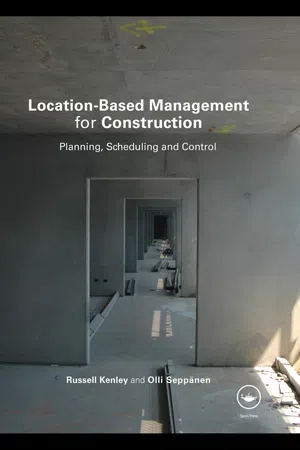
Location-Based Management for Construction
Planning, scheduling and control
- 554 pages
- English
- ePUB (mobile friendly)
- Available on iOS & Android
Location-Based Management for Construction
Planning, scheduling and control
About this book
With extensive case studies for illustration, this is a practitioner's guide to an entirely new production system for construction management using flowline scheduling.
Covering the entire process of presenting a comprehensive management system – from design, through measurement, scheduling, and visualization and control – its emphasis is on reducing cost and increasing quality.
Drawing its components together into a management system, the authors not only include theory and explanations of how and why it works, but also examine and present a suite of methods for successful project implementation.
Perfect as a how-to guide for researchers and advanced construction students to discover the simple application of the new techniques, and invaluable for acquiring the practical tools for planning and controlling projects.
Frequently asked questions
- Essential is ideal for learners and professionals who enjoy exploring a wide range of subjects. Access the Essential Library with 800,000+ trusted titles and best-sellers across business, personal growth, and the humanities. Includes unlimited reading time and Standard Read Aloud voice.
- Complete: Perfect for advanced learners and researchers needing full, unrestricted access. Unlock 1.4M+ books across hundreds of subjects, including academic and specialized titles. The Complete Plan also includes advanced features like Premium Read Aloud and Research Assistant.
Please note we cannot support devices running on iOS 13 and Android 7 or earlier. Learn more about using the app.
Information
Section Five
Case studies
Chapter 15
Case study 1: Opus Business Park
DESCRIPTION OF THE PROJECT


AVAILABLE STARTING DATA
Table of contents
- Cover Page
- Title Page
- Copyright Page
- Figures
- Tables
- Preface
- Acknowledgements
- Permissions
- Section One Introduction to planning and control
- Section Two Location-based planning
- Section Three Location-based control
- Section Four The location-based management system
- Section Five Case studies